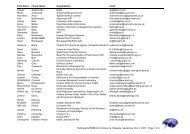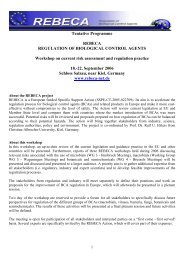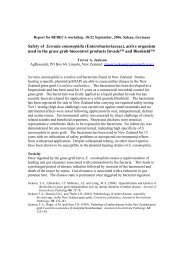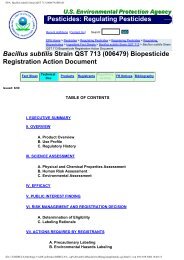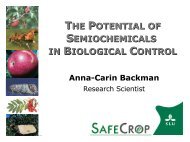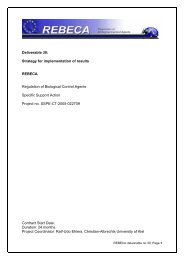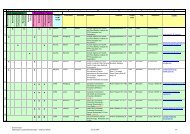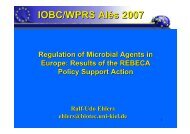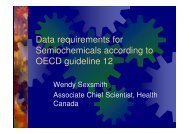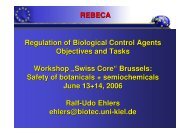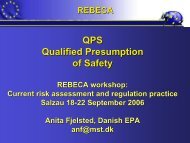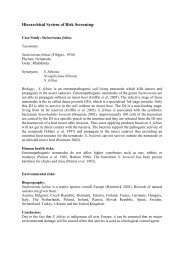Deliverable 28: Specification of low risk products REBECA ...
Deliverable 28: Specification of low risk products REBECA ...
Deliverable 28: Specification of low risk products REBECA ...
Create successful ePaper yourself
Turn your PDF publications into a flip-book with our unique Google optimized e-Paper software.
cannot afford the high costs for a successful registration <strong>of</strong> their biological control<br />
agents (BCAs), which are in most cases niche <strong>products</strong>.<br />
Microbial pesticides are generally regarded as posing <strong>low</strong>er <strong>risk</strong>s to human health<br />
and the environment than chemical pesticides (OECD, 2007). Many governments<br />
have responded to growing public demands for safer means <strong>of</strong> plant protection and<br />
have recognized that the obstacles for safer biological pesticides need to be<br />
addressed. In the European Union, the multidisciplinary <strong>REBECA</strong> (acronym;<br />
Regulation <strong>of</strong> Biological Control Agents) consortium sought to find more appropriate<br />
protocols to address data requirements for biological pesticides and thereby facilitate<br />
access to <strong>low</strong>er <strong>risk</strong> biological controls (<strong>REBECA</strong>, 2007).<br />
In Canada, the pesticide regulatory authority, Health Canada’s Pest Management<br />
Regulatory Agency (PMRA) has waived all registration review fees for microbial<br />
pesticides. To complement this measure, the federal department <strong>of</strong> Agriculture and<br />
Agri-food Canada has set up a regulatory support program for biopesticides needed<br />
by the grower community. The new Canadian pesticide legislation explicitly requires<br />
that the registration to <strong>low</strong>er <strong>risk</strong> <strong>products</strong> will be facilitated by the regulator<br />
(Government <strong>of</strong> Canada, 2002). Both in Canada and in the United States the<br />
respective regulatory agencies have established data requirements that reflect the<br />
current scientific knowledge about the <strong>risk</strong>s posed by microbial pest control agents<br />
(Pest Management Regulatory Agency, 2001; Environmental Protection Agency,<br />
2006).<br />
Unlike chemical pesticides, microbial agents may infect other living organisms<br />
causing diseases. Potential adverse effects <strong>of</strong> microbial pesticides include the<br />
displacement <strong>of</strong> non-target micro-organisms and allergenic, toxic, and pathogenic<br />
effects on humans or other non-target organisms (Cook et al., 1996; OECD, 2003).<br />
The key challenge in <strong>risk</strong> assessment method development is to establish protocols<br />
and guidelines that enable an efficient yet responsible <strong>risk</strong> assessment.<br />
In the area <strong>of</strong> exotic natural enemies van Lenteren et al. (2003) proposed the use <strong>of</strong><br />
a <strong>risk</strong> indicator developed in the ERBIC project (Hokkanen et al., 2003) as an<br />
objective approach to a comparative <strong>risk</strong> assessment <strong>of</strong> “classical biocontrol agents”<br />
(definition as in Eilenberg et al., 2001). This approach has been implemented in a<br />
guideline for the <strong>risk</strong> assessment <strong>of</strong> arthropods as part <strong>of</strong> the OECD Plant Protection<br />
Programme (OECD, 2004a).<br />
Legislators in Canada (Government <strong>of</strong> Canada, 2002) and US EPA (US EPA, 2000)<br />
have recognized the value <strong>of</strong> objectively comparing the <strong>risk</strong>s <strong>of</strong> different pesticides<br />
for the same pattern <strong>of</strong> use and al<strong>low</strong>ing regulators to consider the <strong>risk</strong>s <strong>of</strong> other<br />
pesticides when registering a new product. A similar approach has been suggested<br />
by the European Parliament (European Parliament, 2003).<br />
Several authors have suggested concepts to compare the health or environmental<br />
<strong>risk</strong>s or hazards <strong>of</strong> conventional pesticides, but, unfortunately, the applicability <strong>of</strong><br />
these tools to biological control agents is limited. The availability <strong>of</strong> a tool to<br />
objectively compare the environmental impact <strong>of</strong> biological and conventional<br />
pesticides is desirable in light for the promotion <strong>of</strong> safe biological control options and<br />
the measurement <strong>of</strong> resulting <strong>risk</strong> reduction in agricultural use.<br />
In this paper we propose such a tool for microbial BCAs by using data gathered in<br />
the EU funded BIPESCO (FAIR6-CT-98-4105) and RAFBCA (QLK1-CT-2001-01391)<br />
research projects, as well as data from public regulatory documents and scientific<br />
literature. Selected microbial pest control agents were used to critically review the<br />
14



